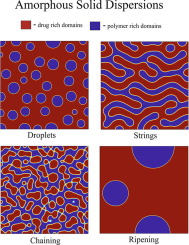当前位置:
X-MOL 学术
›
Acta Biomater.
›
论文详情
Our official English website, www.x-mol.net, welcomes your feedback! (Note: you will need to create a separate account there.)
Modelling phase separation in amorphous solid dispersions.
Acta Biomaterialia ( IF 9.4 ) Pub Date : 2019-06-22 , DOI: 10.1016/j.actbio.2019.06.009 Martin Meere 1 , Giuseppe Pontrelli 2 , Sean McGinty 3
Acta Biomaterialia ( IF 9.4 ) Pub Date : 2019-06-22 , DOI: 10.1016/j.actbio.2019.06.009 Martin Meere 1 , Giuseppe Pontrelli 2 , Sean McGinty 3
Affiliation

|
Much work has been devoted to analysing thermodynamic models for solid dispersions with a view to identifying regions in the phase diagram where amorphous phase separation or drug recrystallization can occur. However, detailed partial differential equation non-equilibrium models that track the evolution of solid dispersions in time and space are lacking. Hence theoretical predictions for the timescale over which phase separation occurs in a solid dispersion are not available. In this paper, we address some of these deficiencies by (i) constructing a general multicomponent diffusion model for a dissolving solid dispersion; (ii) specializing the model to a binary drug/polymer system in storage; (iii) deriving an effective concentration dependent drug diffusion coefficient for the binary system, thereby obtaining a theoretical prediction for the timescale over which phase separation occurs; (iv) calculating the phase diagram for the Felodipine/HPMCAS system; and (iv) presenting a detailed numerical investigation of the Felodipine/HPMCAS system assuming a Flory-Huggins activity coefficient. The numerical simulations exhibit numerous interesting phenomena, such as the formation of polymer droplets and strings, Ostwald ripening/coarsening, phase inversion, and droplet-to-string transitions. A numerical simulation of the fabrication process for a solid dispersion in a hot melt extruder was also presented. STATEMENT OF SIGNIFICANCE: Solid dispersions are products that contain mixtures of drug and other materials e.g. polymer. These are liable to separate-out over time - a phenomenon known as phase separation. This means that it is possible the product differs both compositionally and structurally between the time of manufacture and the time it is taken by the patient, leading to poor bioavailability and so ultimately the shelf-life of the product has to be reduced. Theoretical predictions for the timescale over which phase separation occurs are not currently available. Also lacking are detailed partial differential equation non-equilibrium models that track the evolution of solid dispersions in time and space. This study addresses these issues, before presenting a detailed investigation of a particular drug-polymer system.
中文翻译:

模拟无定形固体分散体中的相分离。
为了确定相图中可能发生非晶相分离或药物重结晶的区域,已进行了大量工作来分析固体分散体的热力学模型。但是,缺乏详细的偏微分方程非平衡模型来跟踪固体分散体在时间和空间上的演化。因此,对于在固体分散体中发生相分离的时间尺度的理论预测是不可用的。在本文中,我们通过(i)构建用于溶解固体分散体的通用多组分扩散模型来解决其中的一些不足。(ii)将模型专门用于存储中的二元药物/聚合物系统;(iii)推导二元系统的有效浓度依赖性药物扩散系数,从而获得发生相分离的时间尺度的理论预测;(iv)计算非洛地平/ HPMCAS系统的相图;(iv)假设Flory-Huggins活度系数,对非洛地平/ HPMCAS系统进行了详细的数值研究。数值模拟显示出许多有趣的现象,例如聚合物液滴和细绳的形成,奥斯特瓦尔德熟化/粗化,相转化以及液滴到细绳的转变。还给出了热熔挤出机中固体分散体制造过程的数值模拟。意义声明:固体分散体是含有药物和其他材料(例如聚合物)混合物的产品。随着时间的流逝,它们易于分离-这种现象被称为相分离。这意味着该产品有可能在制造时间和患者服用时间之间在成分和结构上有所不同,导致生物利用度较差,因此最终必须缩短产品的货架期。当前尚不存在发生相分离的时间尺度的理论预测。还缺少详细的偏微分方程非平衡模型,该模型无法跟踪固体分散体在时间和空间上的演化。在提出对特定药物-聚合物系统的详细研究之前,本研究解决了这些问题。当前尚不存在发生相分离的时间尺度的理论预测。还缺少详细的偏微分方程非平衡模型,该模型无法跟踪固体分散体在时间和空间上的演化。在提出对特定药物-聚合物系统的详细研究之前,本研究解决了这些问题。当前尚不存在发生相分离的时间尺度的理论预测。还缺少详细的偏微分方程非平衡模型,该模型无法跟踪固体分散体在时间和空间上的演化。在提出对特定药物-聚合物系统的详细研究之前,本研究解决了这些问题。
更新日期:2019-06-24
中文翻译:

模拟无定形固体分散体中的相分离。
为了确定相图中可能发生非晶相分离或药物重结晶的区域,已进行了大量工作来分析固体分散体的热力学模型。但是,缺乏详细的偏微分方程非平衡模型来跟踪固体分散体在时间和空间上的演化。因此,对于在固体分散体中发生相分离的时间尺度的理论预测是不可用的。在本文中,我们通过(i)构建用于溶解固体分散体的通用多组分扩散模型来解决其中的一些不足。(ii)将模型专门用于存储中的二元药物/聚合物系统;(iii)推导二元系统的有效浓度依赖性药物扩散系数,从而获得发生相分离的时间尺度的理论预测;(iv)计算非洛地平/ HPMCAS系统的相图;(iv)假设Flory-Huggins活度系数,对非洛地平/ HPMCAS系统进行了详细的数值研究。数值模拟显示出许多有趣的现象,例如聚合物液滴和细绳的形成,奥斯特瓦尔德熟化/粗化,相转化以及液滴到细绳的转变。还给出了热熔挤出机中固体分散体制造过程的数值模拟。意义声明:固体分散体是含有药物和其他材料(例如聚合物)混合物的产品。随着时间的流逝,它们易于分离-这种现象被称为相分离。这意味着该产品有可能在制造时间和患者服用时间之间在成分和结构上有所不同,导致生物利用度较差,因此最终必须缩短产品的货架期。当前尚不存在发生相分离的时间尺度的理论预测。还缺少详细的偏微分方程非平衡模型,该模型无法跟踪固体分散体在时间和空间上的演化。在提出对特定药物-聚合物系统的详细研究之前,本研究解决了这些问题。当前尚不存在发生相分离的时间尺度的理论预测。还缺少详细的偏微分方程非平衡模型,该模型无法跟踪固体分散体在时间和空间上的演化。在提出对特定药物-聚合物系统的详细研究之前,本研究解决了这些问题。当前尚不存在发生相分离的时间尺度的理论预测。还缺少详细的偏微分方程非平衡模型,该模型无法跟踪固体分散体在时间和空间上的演化。在提出对特定药物-聚合物系统的详细研究之前,本研究解决了这些问题。














































 京公网安备 11010802027423号
京公网安备 11010802027423号